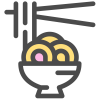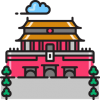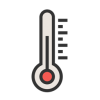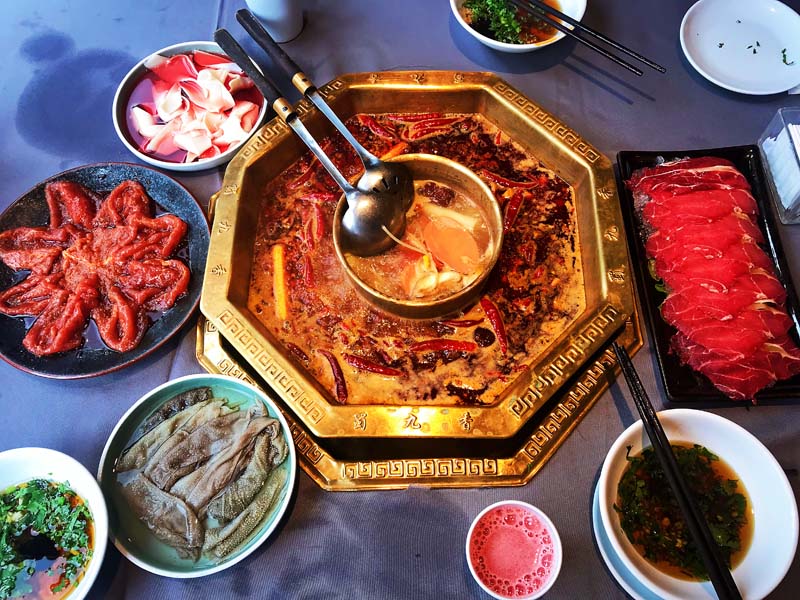
Sichuan cuisine has developed over the centuries. Its distinctive flavors entice people throughout China and recently in foreign countries. Sichuan cuisine is famous for piquancy, but its flavoring is complex as well as hot.
Hot Pot
When people think of Chengdu, they immediately think of hotpot. Introduced from Chongqing, Chengdu hotpot has its own style ranging from simple spicy to moderate, three or four kinds of spices, as well as fish head hotpot, medical herbs hotpot, etc.
Huangcheng Laoma: an old-fashioned hot pot restaurant, regarded as No. 1 among hotpot restaurants in the city. It is situated at No. 20, Qintai Road, Qingyang District, Chengu. A worthy representative of Sichuan culture and diet, Huangcheng Laoma offers hotpot, plus stunning entertainment — a Changing Face opera performance/shadow play.
Chengdu Snacks
Hidden in the streets and lanes of the city, snack bars still send out savory flavors. The most renowned snacks include: Fu Qi Fei Pian (Braised Cow Lungs): Actually beef, heart and tongue take the place of lungs. This tasty dish is made with particular condiments using a delicate process. Chuan Chuan Xiang: also called Ma La Tang, vegetables, sausages, shrimps and anything edible can be threaded onto a bamboo stick and cooked in the hot pot. Lai Tang Yuan (Lai’s Glutinous Rice Ball): the nutritious glutinous rice ball made by Lai (Surname of the maker) is soft and sweet. With more branches than McDonald’s, Lai Tang Yuan is easy to find in Chengdu.
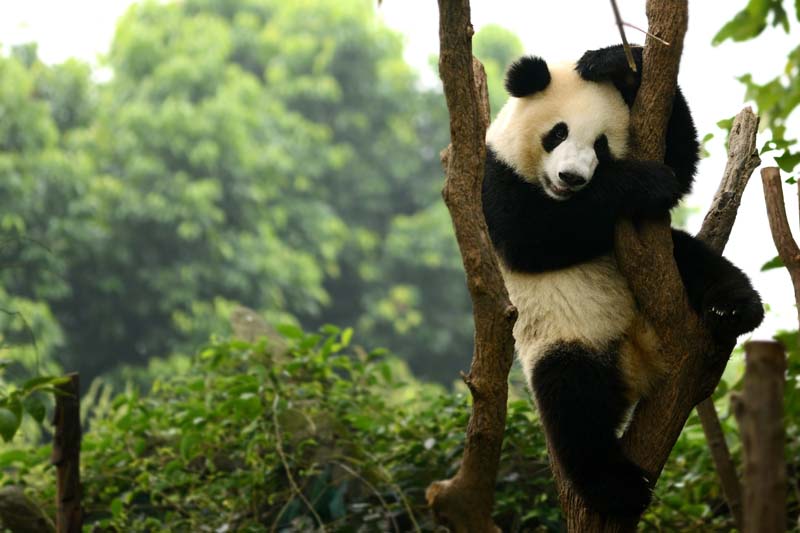
Wolong National Natural Reserve
130 kilometers from Chengdu, Wolong Natural Reserve is renowned as the hometown of giant pandas and the Natural Zoological and Botanical Garden. It’s the earliest, largest and best-known panda reserve in China. It was placed on UNESCO Man and Biosphere Reserve Network in 1980. After the earthquake on May 12, 2008, the pandas were moved to Bifeng Gorge Panda Base .
Three-Star Piles Museum
The Three-Star Piles Museum in Nanxing Town, Guanghan, about 40 kilometers from city proper, exhibits the excavations of the ancient Shu Kingdom. It is an important archeological discovery which changed people’s understanding of ancient history and culture.
Jiuzhaigou Scenic Area
400 kilometers away from Chengdu lies a fairyland whose natural and primitive beauty impresses everyone who visits here. Jiuzhaigou with its heaven-bestowed landscape, precious animals, plants and the special local flavor of the Tibetan People, deserves the first recommendation for a neighborhood tour of Chengdu.
Dujiangyan Irrigation Project
This irrigation project is one of the world’s cultural heritages constructed 2,000 years ago, and amazingly continues to benefit more than 40 neighboring counties. It’s the oldest and only surviving no-dam irrigation system in the world and a wonder in the development of Chinese irrigation works.

Chengdu enjoys a subtropical monsoon climate and also a typical basin climate due to its distinctive location. Generally speaking, the city experience the early spring, muggy and humid summer, cools autumn and warm winter.
Usually the spring comes very early and spring flowers are blossoming just after the Chinese New Year Festival. And autumn is cool and refreshing. Therefore, the spring and autumn are commonly very pleasant and best season for traveling.
The temperature on spring and autumn range from 15-25°C. Summer is very hot and humid and temperature is roughly 20-35°C.
Spring & Summer
Spring
Spring in Chengdu often comes early from the end of February and lasts long until early May. As the temperature rises, colorful flowers are blooming one after another, and trees and grass are turning green under the spring wind.
Summer
Summer here is both hot and rainy, from mid-May to early the end of August. Besides shorts, a thin overcoat and rain gear are also necessary for a summer tour to the trip. At this time, the area is somewhat unpleasant because of the high humidity although the temperature is usually less than 35 °C (95 °F).
Autumn & Winter
Autumn
Autumn usually starts from September and lasts till the end of October or early November. The temperature drops quickly, and there may be a lot of rain. You’d better take long-sleeved T-shirts and thin overcoats plus a thin sweater.
Kalong Valley, Sanjiang and Miyaluo at this time are covered with red maple and yellow chrysanthemum, beautiful and magnificent.
Winter
The average temperature in winter from November to mid-February is about 5 °C (41 °F). However, due to the clouds and moist weather, it feels very cold. You have to wear woolens, down jackets and warm winter boots to spend a winter holiday there.
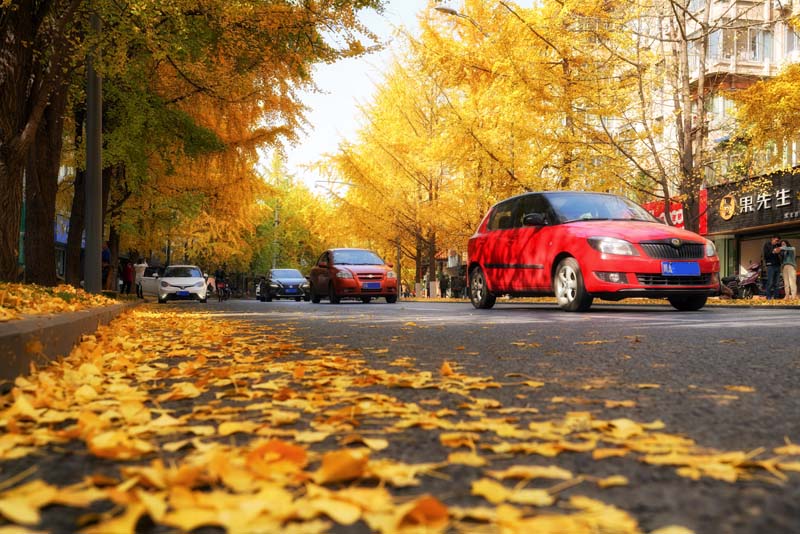
Chengdu International Airport
Chengdu has one airport, the Shuangliu International Airport (CTU), in the southwest of the city. Located about 16 kilometers (10 miles) from the city center, it is the largest aviation hub in central and western China, and aims to form the national aviation hub in mainland China. It has flights to more than 70 domestic cities and over 20 international cities. Frequent one-hour flights are available to Kunming, capital of Yunnan Province. Flights to Xining, capital of Qinghai Province, take about one and a half hours, with two-hour flights available to Lhasa, capital of Tibet. It is convenient to visit the Jiuzhaigou Scenic Spot by air from Chengdu, a 40-minute flight from CTU to Jiuhuang (Jiuzhaigou and Huanglong) Airport with one-way fare of about CNY 700. Visitors are advised to book flights early for this popular trip. Discounts may be available through hotels or travel agencies.
Chengdu Train
As the largest railway hub in southwest China, Chengdu has convenient railway transportation. At present, it has two railway stations for passenger transport: Chengdu Railway Station and East Railway Station. Another two passenger railway stations, south and west railway stations are now under construction. When completed, the “two principals (north and east railway stations), two assistants (south and west railway stations)” setup of Chengdu rail transport will be formed and better serve passengers.
Chengdu Subway
The first line of the Chengdu Metro opened in October 2010, slicing north-south through the city along Renmin Rd and connecting the North and South railway stations together. The fare for a single ride is ¥2-4 depending on distance. You can purchase tickets from machines (English available) with ¥1 coin or ¥5 and ¥10 notes. Ticket booths are also available if you don’t have suitable notes.
When entering the metro you need to put your bags through an X-ray machine. The ticket is flashed by the gates on the reader on your right side. You need the ticket to get out as well, so keep it safe. When exiting, the ticket is placed into a slot that collects it. Again, this slot is on the right side of the gate, so pay attention, since it’s very easy to accidentally open the gate next to you.
Chengdu Taxi
Taxi fare is ¥8 on flag fall for the older taxis and ¥9 for the new ones, and increases at ¥1.9 per km after the first 2 kilometers. For rides from 10 to 60km the km fare is increased by 50% to compensate the taxi returning empty. During night time the starting price is ¥1 more and per km price is ¥2.20. Waiting price for the taxi is one km fare per every five minutes, and the meter counts traveling with speed less than 12 km/h as waiting time. Taxis often refuse to accept ¥100 bills so try to have some change on hand.




